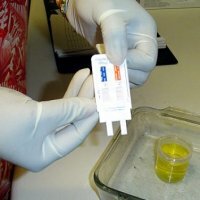Drug analysis for drugs

In the urine, the content of narcotic substances persists longer than in the blood. Most often, the results of urine tests for drugs can be positive in the interval of four to six days after the last dose. However, it should be borne in mind that the above dates are not accurate, they depend on the dose and concentration of the drug taken, as well as on the person's age, weight, kidneys, liver and how often he takes drugs.
Detection of the concentration of cannabinoids( marijuana) in the urine
The essence of the procedure for detecting the concentration of cannabinoids in the urine is the detection of narcotic action in the urine.
Normally, the presence of cannabinoids in the urine should be zero.
The cause of the effect of non-normative indicators is the use of marijuana( quite a bit more than 50 ng / ml).
Possible causes of the absence of cannabinoid in the urine:
- no narcotic substances were administered, or the analysis was too late, or the cannabinoid content in urine did not exceed 50 ng / ml.
Detection of cocaine concentration in urine
This method allows to reveal the content of cocaine or its derivatives that have a narcotic effect in the urine.
Cocaine is one of the strongest drugs that affect the central nervous system. Half-life of cocaine from the body takes place within one hour, while its metabolites take about five hours. If the presence of cocaine is not revealed in the analysis of urine, this does not mean that they did not use it. Therefore, to determine the content of cocaine in the urine, an analysis is carried out for the content of its metabolites in it, which appear in the urine within two days after the cocaine was taken.
Normally, cocaine and its derivatives in urine should not be.
The cause of the occurrence of indicators other than the norm( above 300 ng / ml) is the use of cocaine.
Cocaine and its derivatives in urine are absent:
- if cocaine was not taken
- if the analysis was carried out later than 2 days after cocaine was taken
- if its concentration in urine is less than 300 ng / ml
Detection of urinary amphetamines concentration in the urine
This methodAllows to detect the presence in the urine of amphetamine, a substance that affects the central nervous system.
It is known that in 1887 amphetamine was synthesized. In 1937 it was used in the form of tablets in the treatment of narcolepsy. To use it as a stimulant of steel in the 50s of last century.
In urine, amphetamine can be detected within two days after its administration.
Normally amphetamines should not be present in urine.
The reasons for its occurrence in urine are: its content exceeding 300 ng / ml.
Possible causes of absence of amphetamine in the urine:
- if it was not used by
- if it was used in an amount less than 1000 ng / ml for amphetamine and 500 ng / ml for cases of amphetamine
- if analyzed after 2 days after its administration.
Detection of opiate concentration in urine
This method reveals the content of heroin and its derivatives in the urine.
Opiates are a group of substances that are derived from opium. Opium is obtained from the juice of a plant called Papaver somlliferum.
Opium contains a variety of alkaloids, three of which are used for medical purposes, they are: codeine, morphine, papaverine.
Codeine and morphine are narcotic drugs. However, the most dangerous of all narcotic drugs included in this group is heroin.
Opiates are applied by inhalation, by mouth, in the form of intramuscular and intravenous injections.
Heroin in urine is difficult to detect, becauseIt breaks down very quickly into morphine, which in turn remains in the urine in its pure form in a small amount.
Normally, opiates should not be present in urine.
The cause of opiates in the urine is the intake of one of the drugs belonging to this group in an amount exceeding 300 ng / ml.
Possible causes of absence of morphine in urine:
- if no opiates were taken.
- if the analysis was carried out later than 2 days after their adoption,
- , the accepted dose did not exceed the morphine content in urine above 300 ng / ml.
Detection of morphine in the urine of a person who is not addicted to drug dependence is possible, if he or codeine were used for medical purposes.



